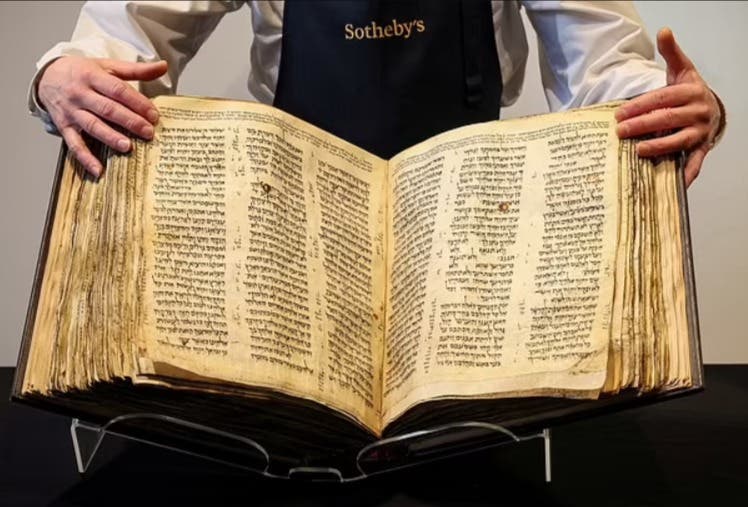Scientists find 1,500 year-old chapter lying hidden within the Bible
An almost lost chapter of the Gospels has been rediscovered by medievalist Grigory Kessel after lying hidden for almost 1,500 years

An almost lost chapter of the Gospels has been rediscovered after lying hidden for almost 1,500 years. (CREDIT: Reuters)
In an extraordinary blend of ancient history and modern technology, an almost lost chapter of the Gospels has been rediscovered after lying hidden for almost 1,500 years.
The driving force behind this sensational discovery is none other than medievalist Grigory Kessel from the Austrian Academy of Sciences (OeAW or Österreichische Akademie der Wissenschaften), who employed ultraviolet photography to unveil the secrets of a unique document: a double palimpsest.
Bridging the Ancient with the Modern
For the uninitiated, a palimpsest is a historical document where an original text was erased, making room for new inscriptions on the same parchment. The document in Kessel’s study, curiously named a 'double palimpsest', contains not one, but three layers of text. It was ultraviolet photography that illuminated the deepest layer, revealing a long-lost chapter of Biblical significance.
This unearthed section is an interpretation of Matthew chapter 12, dating back about 1,500 years. It belongs to a group known as the Old Syriac translations of the Gospels.
Related Stories
But what led to its concealment? The answer lies in the scarcity of parchment in the succeeding centuries. With materials running thin, the invaluable Biblical translations were obscured when the parchments were repurposed.
Grigory Kessel comments on the rarity and significance of his discovery: "Until recently, only two manuscripts were known to contain the Old Syriac translation of the Gospels." One of these precious texts is preserved in London's British Library, while the other surfaced from St. Catherine's Monastery at Mount Sinai under the banner of the "Sinai Palimpsests Project".
The document Kessel scrutinized emerges as the fourth in this series. It offers insights into a translation of a 3rd-century text, most likely replicated in the 6th century, and was safeguarded within the esteemed Vatican Library.
The hidden Bible chapter was uncovered by a so-called palimpsest Grigory Kessel (CREDIT: OeAW)
Claudia Rapp, director of the Institute for Medieval Research at the OeAW, lauds Kessel's profound accomplishment: "Grigory Kessel has made a great discovery thanks to his profound knowledge of old Syriac texts and script characteristics." It stands as a testament to the unyielding spirit of scholars and the lengths they'll traverse to uncover forgotten history.
Historically, while fragments of the New Testament are traceable to the 3rd century, the title of the oldest known complete manuscript of the New Testament is held by the Greek Codex Sinaiticus, which dates back to the 6th century.
Vat. iber. 4, ff. 5v + 1r (= verso) (CREDIT: Biblioteca Apostolica Vaticana. Reproduced by permission of Biblioteca Apostolica Vaticana, with all rights reserved)
These Old Syriac translations, as revealed by the OeAW, are potentially even older, existing before the 6th century. However, their remnants are primarily detected in palimpsests, trapped within the erased strata of parchment.
The Fusion of Technology and History
The critical role of ultraviolet photography in this discovery cannot be understated. "This discovery proves," Rapp elaborates, "how productive and important the interplay between modern digital technologies and basic research can be when dealing with medieval manuscripts." It's a glorious confluence of ancient manuscripts and cutting-edge technological tools, setting the stage for more such groundbreaking revelations in the future.
Vat. iber. 4, ff. 5r + 1v (= recto) (CREDIT: Biblioteca Apostolica Vaticana. Reproduced by permission of Biblioteca Apostolica Vaticana, with all rights reserved)
The unearthing of this Gospel text exemplifies the untapped potential of combining contemporary technological advancements with the age-old art of manuscript research. As digital techniques become increasingly sophisticated, they offer a renewed hope for scholars like Kessel to delve deeper into history, bringing long-concealed truths to light.
As we stand at this intersection of the past and the future, it's exciting to ponder what other treasures await discovery in the hidden recesses of ancient parchments and the vast vaults of our world's libraries.
For more science and technology stories check out our New Discoveries section at The Brighter Side of News.
Note: Materials provided above by The Brighter Side of News. Content may be edited for style and length.
Like these kind of feel good stories? Get the Brighter Side of News' newsletter.
Joseph Shavit
Head Science News Writer | Communicating Innovation & Discovery
Based in Los Angeles, Joseph Shavit is an accomplished science journalist, head science news writer and co-founder at The Brighter Side of News, where he translates cutting-edge discoveries into compelling stories for a broad audience. With a strong background spanning science, business, product management, media leadership, and entrepreneurship, Joseph brings a unique perspective to science communication. His expertise allows him to uncover the intersection of technological advancements and market potential, shedding light on how groundbreaking research evolves into transformative products and industries.



